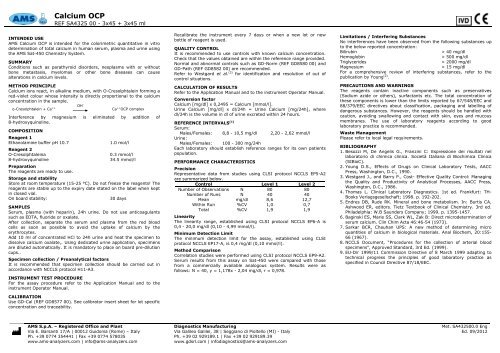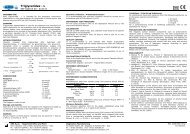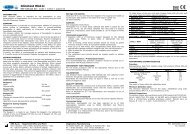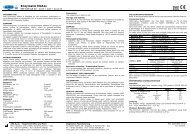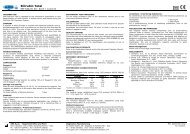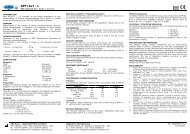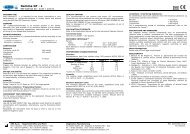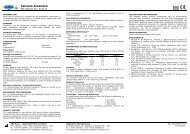Create successful ePaper yourself
Turn your PDF publications into a flip-book with our unique Google optimized e-Paper software.
<strong>Calcium</strong> <strong>OCP</strong><br />
REF SA4325 00 - 3x45 + 3x45 ml<br />
INTENDED USE<br />
AMS <strong>Calcium</strong> <strong>OCP</strong> is intended for the colorimetric quantitative in vitro<br />
determination of total calcium in human serum, plasma and urine using<br />
the AMS Sat-450 Chemistry System.<br />
SUMMARY<br />
Conditions such as parathyroid disorders, neoplasms with or without<br />
bone metastasis, myelomas or other bone diseases can cause<br />
alterations in calcium levels.<br />
METHOD PRINCIPLE<br />
<strong>Calcium</strong> ions react, in alkaline medium, with O-Cresolphtalein forming a<br />
red-violet colour whose intensity is directly proportional to the calcium<br />
concentration in the sample.<br />
o-Cresolphtalein + Ca ++<br />
OH -<br />
Ca ++ <strong>OCP</strong> <strong>com</strong>plex<br />
Interference by magnesium is eliminated by addition of<br />
8-hydroxyquinoline.<br />
COMPOSITION<br />
Reagent 1<br />
Ethanolamine buffer pH 10.7 1.0 mol/l<br />
Reagent 2<br />
O-Cresolphtaleina 0.3 mmol/l<br />
8-hydroxyquinoline 34.5 mmol/l<br />
Preparation<br />
The reagents are ready to use.<br />
Storage and stability<br />
Store at room temperature (15-25 °C). Do not freeze the reagents! The<br />
reagents are stable up to the expiry date stated on the label when kept<br />
in closed vial.<br />
On board stability: 30 days<br />
SAMPLES<br />
Serum, plasma (with heparin), 24h urine. Do not use anticoagulants<br />
such as EDTA, fluoride or oxalate.<br />
After collection, separate the serum and plasma from the red blood<br />
cells as soon as possible to avoid the uptake of calcium by the<br />
erythrocytes.<br />
Add 10 ml of concentrated HCl to 24h urine and heat the specimen to<br />
dissolve calcium oxalate,. Using dedicated urine application, specimens<br />
are diluted automatically. It is mandatory to place on board pre-dilution<br />
cups..<br />
Specimen collection / Preanalytical factors<br />
It is re<strong>com</strong>mended that specimen collection should be carried out in<br />
accordance with NCCLS protocol H11-A3.<br />
INSTRUMENT TEST PROCEDURE<br />
For the assay procedure refer to the Application Manual and to the<br />
instrument Operator Manual.<br />
CALIBRATION<br />
Use GD-Cal (REF GD8577 00). See calibrator insert sheet for lot specific<br />
concentration and traceability.<br />
Recalibrate the instrument every 7 days or when a new lot or new<br />
bottle of reagent is used.<br />
QUALITY CONTROL<br />
It is re<strong>com</strong>mended to use controls with known calcium concentration.<br />
Check that the values obtained are within the reference range provided.<br />
Normal and abnormal controls such as GD-Norm (REF GD8580 00) and<br />
GD-Path (REF GD8582 00) are re<strong>com</strong>mended.<br />
Refer to Westgard et al. (3) for identification and resolution of out of<br />
control situations.<br />
CALCULATION OF RESULTS<br />
Refer to the Application Manual and to the instrument Operator Manual.<br />
Conversion factor<br />
<strong>Calcium</strong> [mg/dl] x 0,2495 = <strong>Calcium</strong> [mmol/l].<br />
Urine <strong>Calcium</strong> [mg/dl] x dl/24h = Urine <strong>Calcium</strong> [mg/24h], where<br />
dl/24h is the volume in dl of urine excreted within 24 hours.<br />
REFERENCE INTERVALS (1)<br />
Serum:<br />
Males/Females: 8,8 - 10,5 mg/dl 2,20 - 2,62 mmol/l<br />
Urine:<br />
Males/Females: 100 - 300 mg/24h<br />
Each laboratory should establish reference ranges for its own patients<br />
population.<br />
PERFORMANCE CHARACTERISTICS<br />
Precision<br />
Representative data from studies using CLSI protocol NCCLS EP5-A2<br />
are summarized below.<br />
Control Level 1 Level 2<br />
Number of Observations N 80 80<br />
Number of Runs N 40 40<br />
Mean mg/dl 8,6 12,7<br />
Within Run %CV 1,0 0,7<br />
Total %CV 1,9 1,9<br />
Linearity<br />
The linearity range, established using CLSI protocol NCCLS EP6-A is<br />
0,4 - 20,0 mg/dl (0,10 - 4,99 mmol/l).<br />
Minimum Detection Limit<br />
The minimum detection limit for the assay, established using CLSI<br />
protocol NCCLS EP17-A, is 0,4 mg/dl (0,10 mmol/l).<br />
Method Comparison<br />
Correlation studies were performed using CLSI protocol NCCLS EP9-A2.<br />
Serum results from this assay on Sat-450 were <strong>com</strong>pared with those<br />
from a <strong>com</strong>mercially available analogous system. Results were as<br />
follows: N = 40, y = 1,178x - 2,04 mg/dl, r = 0,978.<br />
AMS S.p.A. – Registered Office and Plant Diagnostics Manufacturing<br />
Via E. Barsanti 17/A | 00012 Guidonia (Rome) – Italy Via Galileo Galilei, 38 | Seggiano di Pioltello (MI) - Italy<br />
Ph. +39 0774 354441 | Fax +39 0774 578035 Ph. +39 02 929189.1 | Fax +39 02 929189.39<br />
www.ams-analyzers.<strong>com</strong> | info@ams-analyzers.<strong>com</strong> www.gdsrl.<strong>com</strong> | infodiagnostics@ams-analyzers.<strong>com</strong><br />
Limitations / Interfering Substances<br />
No interferences have been observed from the following substances up<br />
to the below reported concentration:<br />
Bilirubin > 40 mg/dl<br />
Hemoglobin > 500 mg/dl<br />
Triglycerides > 2000 mg/dl<br />
Magnesium > 15 mg/dl<br />
For a <strong>com</strong>prehensive review of interfering substances, refer to the<br />
publication by Young (2) .<br />
PRECAUTIONS AND WARNINGS<br />
The reagents contain inactive <strong>com</strong>ponents such as preservatives<br />
(Sodium azide or others), surfactants etc. The total concentration of<br />
these <strong>com</strong>ponents is lower than the limits reported by 67/548/EEC and<br />
88/379/EEC directives about classification, packaging and labelling of<br />
dangerous substances. However, the reagents should be handled with<br />
caution, avoiding swallowing and contact with skin, eyes and mucous<br />
membranes. The use of laboratory reagents according to good<br />
laboratory practice is re<strong>com</strong>mended.<br />
Waste Management<br />
Please refer to local legal requirements.<br />
BIBLIOGRAPHY<br />
1. Besozzi M, De Angelis G., Franzini C: Espressione dei risultati nel<br />
laboratorio di chimica clinica. Società Italiana di Biochimica Clinica<br />
(SIBioC).<br />
2. Young D.S., Effects of Drugs on Clinical Laboratory Tests, AACC<br />
Press, Washington, D.C., 1990.<br />
3. Westgard J., and Barry P., Cost- Effective Quality Control: Managing<br />
the Quality and Productivity of Analytical Processes, AACC Press,<br />
Washington, D.C., 1986.<br />
4. Thomas L. Clinical Laboratory Diagnostics. 1st ed. Frankfurt: TH-<br />
Books Verlagsgesellschaft; 1998. p. 192-202.<br />
5. Endres DB, Rude RK. Mineral and bone metabolism. In: Burtis CA,<br />
Ashwood ER, editors. Tietz Textbook of Clinical Chemistry. 3rd ed.<br />
Philadelphia: W.B Saunders Company; 1999. p. 1395-1457.<br />
6. Baginski ES, Marie SS, Clark WL, Zak B: Direct microdetermination of<br />
serum calcium. Clin Chim Acta 46:46-54 (1973).<br />
7. Sarkar BCR, Chauhan UPS: A new method of determining micro<br />
quantities of calcium in biological materials. Anal Biochem, 20:155-<br />
66 (1967).<br />
8. NCCLS Document, “Procedures for the collection of arterial blood<br />
specimens”, Approved Standard, 3rd Ed. (1999).<br />
9. EU-Dir 1999/11 Commission Directive of 8 March 1999 adapting to<br />
technical progress the principles of good laboratory practice as<br />
specified in Council Directive 87/18/EEC.<br />
Met. SA432500.0 Eng<br />
Ed. 09/2012
Calcio <strong>OCP</strong><br />
REF SA4325 00 - 3x45 + 3x45 ml<br />
USO<br />
Il kit AMS Calcio <strong>OCP</strong> viene impiegato per la determinazione<br />
colorimetrica quantitativa in vitro del calcio totale nel siero, plasma ed<br />
urina umana con sistema AMS Sat-450.<br />
SOMMARIO<br />
Alterazioni dei livelli di calcio si possono trovare in diverse patologie<br />
<strong>com</strong>e disturbi della paratiroide, neoplasie con e senza metastasi ossee,<br />
mielomi e altre malattie ossee.<br />
PRINCIPIO<br />
Gli ioni calcio reagiscono, in ambiente alcalino, con il cromogeno<br />
O-Cresolftaleina sviluppando un colore porpora. La densità di colore<br />
sviluppata è direttamente proporzionale alla concentrazione di ioni<br />
calcio presenti nel campione.<br />
o-Cresolftaleina + Ca ++<br />
OH -<br />
Ca ++ <strong>OCP</strong> <strong>com</strong>plesso<br />
L'interferenza degli ioni Magnesio viene bloccata con<br />
l'8-idrossichinolina.<br />
COMPOSIZIONE<br />
Reagente 1<br />
Tampone etanolammina pH 10.7 1.0 mol/l<br />
Reagente 2<br />
O-Cresolftaleina 0.3 mmol/l<br />
8-idrossichinolina 34.5 mmol/l<br />
Preparazione<br />
I reagenti sono pronti all’uso.<br />
Conservazione e Stabilità<br />
Conservare a temperatura ambiente (15-25 °C). Non congelare i<br />
reattivi! I reattivi sono stabili fino alla data di scadenza riportata in<br />
etichetta, se conservati in flacone chiuso.<br />
Stabilità a bordo dello strumento: 30 giorni<br />
CAMPIONI<br />
Siero, plasma (con eparina), urine delle 24 ore. Non usare<br />
anticoagulanti quali EDTA, fluoruro o ossalato.<br />
Separare appena possibile il siero o il plasma dai globuli rossi per<br />
evitare l'assunzione di calcio dagli eritrociti.<br />
Aggiungere 10 ml di HCl concentrato alle urine delle 24 ore e scaldare il<br />
campione per sciogliere l'ossalato di calcio. Usando l’applicazione<br />
dedicata per le urine i campioni vengono diluiti automaticamente. E’<br />
necessario posizionare a bordo dello strumento le coppette di prediluizione.<br />
Raccolta dei Campioni / Fattori Preanalitici<br />
Si rac<strong>com</strong>anda di effettuare la raccolta dei campioni in conformità al<br />
Protocollo NCCLS H11-A3.<br />
PROCEDURA DI ANALISI<br />
Per la procedura di analisi fare riferimento all’Application Manual e al<br />
Manuale dell’Operatore dello strumento.<br />
CALIBRAZIONE<br />
Utilizzare GD-Cal (REF GD8577 00). Riferirsi all’inserto del calibratore<br />
per la concentrazione specifica del lotto e la tracciabilità.<br />
Ricalibrare lo strumento ogni 7 giorni o quando viene utilizzato un<br />
nuovo lotto o una nuova bottiglia di reagente.<br />
CONTROLLO DI QUALITA’<br />
Si rac<strong>com</strong>anda l’uso di controlli a titolo noto di calcio. Verificare che il<br />
valore ottenuto sia all’interno degli intervalli di accettabilità forniti. Si<br />
consiglia l’uso di controlli Normale e Patologico <strong>com</strong>e GD-Norm (REF<br />
GD8580 00) e GD-Path (REF GD8582 00).<br />
Far riferimento a Westgard et al. (3) per l’identificazione e la risoluzione<br />
di problematiche legate ai controlli fuori dai limiti.<br />
CALCOLO DEI RISULTATI<br />
Riferirsi all’Application Manual e al Manuale dell’Operatore dello<br />
strumento.<br />
Fattori di Conversione<br />
Calcio [mg/dl] x 0,2495 = Calcio [mmol/l].<br />
Calcio Urine [mg/dl] x dl/24h = Calcio Urine [mg/24h], dove dl/24h<br />
rappresenta il volume in dl di urina escreta nelle 24 ore.<br />
INTERVALLO DI RIFERIMENTO (1)<br />
Siero:<br />
Uomini/Donne: 8,8 - 10,5 mg/dl 2,20 - 2,62 mmol/l<br />
Urine:<br />
Uomini/Donne: 100 - 300 mg/24h<br />
Si rac<strong>com</strong>anda ad ogni laboratorio di stabilire i propri valori normali in<br />
funzione della popolazione su cui opera.<br />
PRESTAZIONI ANALITICHE<br />
Precisione<br />
Dati rappresentativi dello studio secondo il protocollo CLSI NCCLS<br />
EP5-A2 sono sotto riportati.<br />
Controllo Livello 1 Livello2<br />
Numero di Osservazioni N 80 80<br />
Numero di Prove N 40 40<br />
Media mg/dl 8,6 12,7<br />
Nella Corsa %CV 1,0 0,7<br />
Totale %CV 1,9 1,9<br />
Linearità<br />
L’intervallo di linearità, stabilito tramite il protocollo CLSI NCCLS EP6-A<br />
è risultato pari a 0,4 - 20,0 mg/dl (0,10 - 4,99 mmol/l).<br />
Limite Minimo di Rivelabilità<br />
Il limite minimo di rilevabilità, stabilito tramite il protocollo CLSI NCCLS<br />
EP17-A, è 0,4 mg/dl (0,10 mmol/l).<br />
Comparazione fra Metodi<br />
Studi di correlazione sono stati effettuati secondo il protocollo CLSI<br />
NCCLS EP9-A2. I risultati dei sieri di questo dosaggio su Sat-450 sono<br />
stati confrontati con un sistema analogo presente in <strong>com</strong>mercio. I<br />
risultati sono stati i seguenti: N = 40, y = 1,178x - 2,04 mg/dl, r =<br />
0,978.<br />
AMS S.p.A. – Sede Legale e Stabilimento Produzione Diagnostici<br />
Via E. Barsanti 17/A | 00012 Guidonia (Roma) – Italia Via Galileo Galilei, 38 | Seggiano di Pioltello (MI) - Italia<br />
Tel. +39 0774 354441 | Fax +39 0774 578035 Tel. +39 02 929189.1 | Fax +39 02 929189.39<br />
www.ams-analyzers.<strong>com</strong> | info@ams-analyzers.<strong>com</strong> www.gdsrl.<strong>com</strong> | infodiagnostics@ams-analyzers.<strong>com</strong><br />
Limitazioni / Sostanze Interferenti<br />
Nessuna interferenza è stata osservata dalle seguenti sostanze fino alla<br />
concentrazione sotto indicata:<br />
Bilirubina > 40 mg/dl<br />
Emoglobina > 500 mg/dl<br />
Trigliceridi > 2000 mg/dl<br />
Magnesio > 15 mg/dl<br />
Per una panoramica <strong>com</strong>pleta sulle sostanze interferenti si rimanda alla<br />
pubblicazione di Young (2) .<br />
PRECAUZIONI E AVVERTENZE<br />
I reagenti contengono <strong>com</strong>ponenti inattivi, quali i conservanti (Sodio<br />
azide o altri), tensioattivi ecc. La concentrazione totale di questi<br />
<strong>com</strong>ponenti è inferiore ai limiti riportati dalle direttive CEE 67/548/EEC<br />
e 88/379/EEC sulla classificazione, l’imballaggio ed etichettatura delle<br />
sostanze pericolose. Tuttavia i reagenti devono essere trattati con<br />
cautela, evitandone l’ingestione, il contatto con la pelle, gli occhi e le<br />
membrane mucose.<br />
Nell’utilizzo dei reagenti di laboratorio si rac<strong>com</strong>anda di seguire le<br />
norme di buona pratica di laboratorio.<br />
Gestione dei Rifiuti<br />
Attenersi alle norme locali per quanto riguarda lo smaltimento dei<br />
reagenti.<br />
BIBLIOGRAFIA<br />
1. Besozzi M, De Angelis G., Franzini C: Espressione dei risultati nel<br />
laboratorio di chimica clinica. Società Italiana di Biochimica Clinica<br />
(SIBioC).<br />
2. Young D.S., Effects of Drugs on Clinical Laboratory Tests, AACC<br />
Press, Washington, D.C., 1990.<br />
3. Westgard J., and Barry P., Cost- Effective Quality Control: Managing<br />
the Quality and Productivity of Analytical Processes, AACC Press,<br />
Washington, D.C., 1986.<br />
4. Thomas L. Clinical Laboratory Diagnostics. 1st ed. Frankfurt: TH-<br />
Books Verlagsgesellschaft; 1998. p. 192-202.<br />
5. Endres DB, Rude RK. Mineral and bone metabolism. In: Burtis CA,<br />
Ashwood ER, editors. Tietz Textbook of Clinical Chemistry. 3rd ed.<br />
Philadelphia: W.B Saunders Company; 1999. p. 1395-1457.<br />
6. Baginski ES, Marie SS, Clark WL, Zak B: Direct microdetermination of<br />
serum calcium. Clin Chim Acta 46:46-54 (1973).<br />
7. Sarkar BCR, Chauhan UPS: A new method of determining micro<br />
quantities of calcium in biological materials. Anal Biochem, 20:155-<br />
66 (1967).<br />
8. NCCLS Document, “Procedures for the collection of arterial blood<br />
specimens”, Approved Standard, 3rd Ed. (1999).<br />
9. EU-Dir 1999/11 Commission Directive of 8 March 1999 adapting to<br />
technical progress the principles of good laboratory practice as<br />
specified in Council Directive 87/18/EEC.<br />
Met. SA432500.0 Ita<br />
Ed. 09/2012


